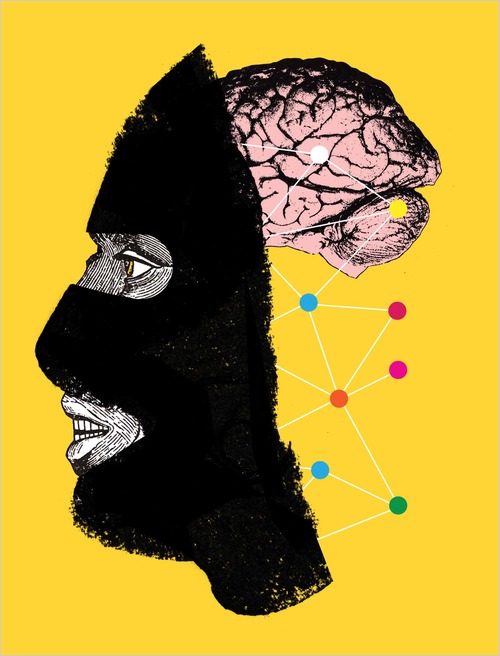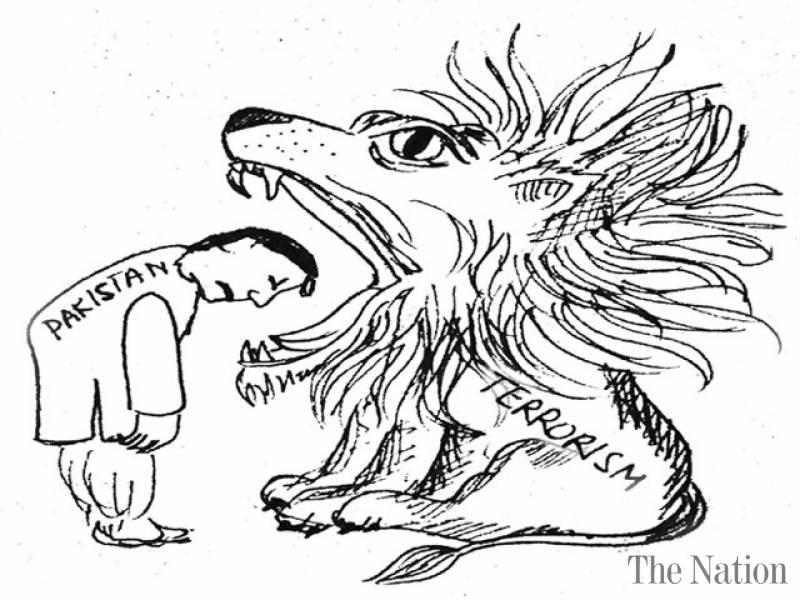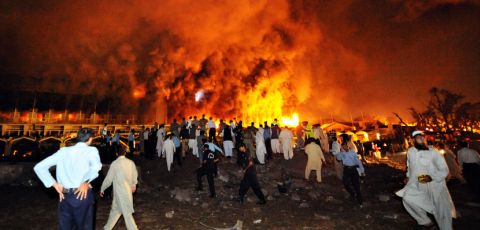A Psychopathological Perspective in Neo-Colonial Era. The thesis shall be published in 7 episodes. A detail of the references shall be given in the last episode.
The attacks on twin towers in September 2001 changed the world. If it is true, it is yet to be determined whether the “attacks” changed the world or the way they were responded to. A lot has been said, written and done about it but as suggested, the world is, being perceived as more unsafe than before 9/11. Beside  the feelings of horror, uncertainty and dismay, which went high among the masses, the biggest psychological damage caused by 9/11 and its aftermath, was the negative perception people of different regions, religions and cultures have developed about each other. Thesis of the “Clash of Civilization” became a hot topic a decade after of its writing. The task of analyzing the situation was given to the misinformation experts (Ali et al 2011) and their analysis of incidents on 9/11 was aired by the corporate media. Pakistan received its share of blame in the analysis as it had previously launched a unique war against the communist Soviet Union. As it has been suggested Pakistan has designed, preached and exported the legacy of extremism to the Muslim world to get as many recruits as possible. The extremists in Pakistan, as it was analyzed, are strong, powerful and big in numbers so that no Government in Islamabad can control them. In addition, the nuclear assets could go into extremist’s hands at any time. The perception of “extremist Pakistan” resonated so strong in the West that as soon as one may view a book with a title of bearded and turbaned youth shouting, one would relate it to Pakistan.
the feelings of horror, uncertainty and dismay, which went high among the masses, the biggest psychological damage caused by 9/11 and its aftermath, was the negative perception people of different regions, religions and cultures have developed about each other. Thesis of the “Clash of Civilization” became a hot topic a decade after of its writing. The task of analyzing the situation was given to the misinformation experts (Ali et al 2011) and their analysis of incidents on 9/11 was aired by the corporate media. Pakistan received its share of blame in the analysis as it had previously launched a unique war against the communist Soviet Union. As it has been suggested Pakistan has designed, preached and exported the legacy of extremism to the Muslim world to get as many recruits as possible. The extremists in Pakistan, as it was analyzed, are strong, powerful and big in numbers so that no Government in Islamabad can control them. In addition, the nuclear assets could go into extremist’s hands at any time. The perception of “extremist Pakistan” resonated so strong in the West that as soon as one may view a book with a title of bearded and turbaned youth shouting, one would relate it to Pakistan.
The West prefers to view Pakistan through a single optic. European and North American papers give the impression that the main, if not the only, problem confronting Pakistan is the powers of the bearded fanatics skulking in Hindu Kush, who, as the papers see it, are on the verge of taking over the country (Ali 2008, p.4).
Some Western analysts believe that these “bearded fanatics” have the benefit of the mass support in Pakistan.
When terrorist groups attack India, or Western forces in Afghanistan, their actions enjoy a degree of instinctive, gut sympathy from a majority of Pakistanis – not because of Islamist extremism, but because of Muslim nationalism and bitter hostility to the US role in the Muslim world in general and Pakistan’s region in particular (Lieven 2011, p.5)
The message Western analysts try to communicate is, that although a majority is not involved in carrying out terrorist attacks, it shares the ideology and morally espouse the activities of terrorists.
Radicalization of Pakistani society is a notion which has been used very loosely and often superficially.  The three definitions of the phenomenon of “radicalization” quoted before the participants of a debate organized by Pak Institute for Peace were a reflection of a particular political and oriental context (PIPS 2009). However, the terrorist attacks, bomb blasts, attacks on military instillations still needed to be comprehended and explained. Pakistan lost 36,000 innocent men and $70 billion in fighting against the terrorism. (Al Arabiya News 2012). Some other sources show some different figures.
The three definitions of the phenomenon of “radicalization” quoted before the participants of a debate organized by Pak Institute for Peace were a reflection of a particular political and oriental context (PIPS 2009). However, the terrorist attacks, bomb blasts, attacks on military instillations still needed to be comprehended and explained. Pakistan lost 36,000 innocent men and $70 billion in fighting against the terrorism. (Al Arabiya News 2012). Some other sources show some different figures.
Table: 1. Annual Fatalities in Terrorist Violence in Pakistan, 2003- Feb. 2012
| Year | Civilians | Security Force Personnel | Terrorists/Insurgents | Total |
| 2003 | 140 | 24 | 25 | 189 |
| 2004 | 435 | 184 | 244 | 863 |
| 2005 | 430 | 81 | 137 | 648 |
| 2006 | 608 | 325 | 538 | 1471 |
| 2007 | 1522 | 597 | 1479 | 3598 |
| 2008 | 2155 | 654 | 3906 | 6715 |
| 2009 | 2324 | 991 | 8389 | 11704 |
| 2010 | 1796 | 469 | 5170 | 7435 |
| 2011 | 2580 | 765 | 2797 | 6142 |
| Feb. 2012 | 325 | 176 | 427 | 988 |
| Total | 12315 | 4266 | 23112 | 39693 |
(Source: http://www.satp.org/satporgtp/countries/pakistan/database/casualties.htm)
No social institution, religious group or a political party (except few religious ones) could escape being the target of terrorists. Mosques, Imambargah, shrines of Saints, Markets, schools, political and religious gatherings and even funeral processions have been targeted by terrorists. Syed (2011) suggested that Pakistan is setting new trends for suicide attacks. There are a number of reasons; he refers to, which make Pakistan an exclusive case to study.
The regions known to have frequent suicide attacks have two main motivations, foreign occupation (like in Iraq and Afghanistan) and a liberation movement (similar to the Palestine and Sri Lanka). Pakistan is the only country enduring frequent suicide attack without having any of the above mentioned reasons. Syed (2011) made an important finding about the pattern of suicide attacks in Pakistan. “Like Iraq, suicide attackers in Pakistan have no single agenda to run or a specific group to target. From masses to mosques, from security forces to clerics of other sects, from children to religious processions a wide range of people have remained the targets. Other regions, like Israel and Sri Lanka, targets of suicide attacks were known, predictable and were relevant in the political crisis of the particular region.” (Syed 2011. p. 85).
These violent trends are considered a portrayal of social anger in Pakistani society. In August 2010, Sialkot, a notable industrial city of Pakistan witnessed a lynch mob killing of two brothers in the presence of Police officers and hundreds of bystanders. In August 2009, four women, a man and a child all belonging to the Christian community were murdered by a mob in Gojra. In January 2011, the Governor of Punjab was killed by his own security guard as his comments on one law annoyed the murderer. Religious leaders refused to perform his funeral service. Rather, his murderer was showered with petals on his arrival to the court. Many lawyers proudly advocated the murderer’s case as they were all annoyed with the slain Governor. In the case of petty crimes, if a mob apprehends, the perpetrators are generally beaten to death or burnt alive. This level and nature of violence is a hot topic for journalists, political analysts, politicians and for academic circles. Several experts have attempted to investigate these trends from their respective perspectives.
A number of approaches are employed to interpret the situation in Pakistan. The majority of analysts have attempted to view the current troubled situation from the perspective of the situation emerged after the Russian invasion in Afghanistan and its after-effects on the region in general and Pakistan in particular (Akbar, 2011; Ali 2008; Leiven, 2011). Some have used the current scene of International  politics and country’s internal structures to explain the current state (Jones 2002). Some analysts employed the religious history of the subcontinent as a factor in explaining the current trends of violence in the region (Jalal 2008). While some have tried to investigate into the events leading to 9/11 and its aftermath (Rashid 2008). Ahmed (2011), looked into these violent trends from the confines of sectarian schism in Pakistan.
politics and country’s internal structures to explain the current state (Jones 2002). Some analysts employed the religious history of the subcontinent as a factor in explaining the current trends of violence in the region (Jalal 2008). While some have tried to investigate into the events leading to 9/11 and its aftermath (Rashid 2008). Ahmed (2011), looked into these violent trends from the confines of sectarian schism in Pakistan.
It may be argued that what is the source of this anger which has encouraged such violent acts of terrorism? In the last decade a number of hypotheses have been proposed. Esposito and Mogahed (2007) analyzed the hypotheses suggested about the sources of anger, radicalization and terrorism among the Muslim community. As it is suggested that these violent trends are the outcome of an abnormal, deranged and irrational mindset (psychological hypothesis), the terrorists are socially misfit, alienated and lacking education (sociological hypothesis), they belong to poor and lower economic groups of society (economic hypothesis), they abhor democracy and averse human rights and modern concepts of freedom (political hypothesis), they are radicals, fanatics, believe in violence (religious hypothesis).
Robert Pape (2005), in his study did not find any psychological disorder in the perpetrators of suicide attacks, the most lethal form of terrorism and violence. The attackers involved in 9/11 were well educated and most of them belonged to wealthy families. The attackers involved in the London bombing were well educated, belonged to middle class families and some of them were born in the UK. For instance, the British born, Omer Sheikh who was convicted for the Wall Street Journal’s Daniel Pearl’s murder was educated at the London School of Economics. Pape (2005), Esposito & Mogahed (2007) rejected the religious hypothesis for several reasons. One, terrorism is not exclusively a Muslim phenomenon, two, many terrorists were not practicing Muslims and three, in many instances they knew very little about religion.
What are the psycho-social factors involved in terrorism in different regions of the world? Is there any relationship between International terrorism and the situation in Pakistan? Do the above mentioned hypotheses provide any help to understand and explain the situation in Pakistan? Syed (2011), made a forceful assertion on the exceptionality and matchlessness of the situation in Pakistan in terms of violence and suicide terrorism. He concluded that it is very difficult, if not impossible to find one reason for the phenomenon of violence in Pakistan. Should we look for some other viable hypothesis or paradigm to explain the badly troubled psycho-social conditions in Pakistan?
Anger: A Multilayered Phenomenon?
From Ancient Philosophers to Medieval Thinkers and up to modern times theories of anger keep evolving. The significant difference, in recent thinkers theories is an attempt to understand it instead of simply condemning it. This may be the main reason why social thinkers (mainly Psychologists) are more focused on its causes. Izard (1991), identified five major causes of anger; 1) restraint, 2) blocking or interrupting of goal directed activity 3) aversive stimulation, 4) being misled or unjustly hurt, 5) moral indignation. In his views, it is a complex emotion and a combination of disgust, contempt and of adaptation. Izrad made some interesting observations. He suggested that leaving anger unexpressed could cause serious health issues. In his views, anger is not the only cause of aggression rather “appropriate expression of justified anger may even strengthen the relationship between the angry person and the person who is the target of anger”. (p. 209)
Lazarus (1991) views anger as an outcome of harm, loss or threat, which needs someone to blame (for inflicting harm, loss or threat). He argued how people struggle for the preservation of their ego identity and any assault to that causes anger. This type and severity of this anger depends on two factors, 1) personality and 2) recent patterns of individual’s being demeaned. In his words, anger in adults is incited by “a demeaning offence against me and mine” (p. 221), and even a minor obstruction could be considered as demeaning.
Averill (1982) defined this conflicting emotion at three different levels of human existence. From the biological perspective anger is “related to aggressive systems and, even more important, to the capacities for co-operative social living, symbolization and reflective self-awareness”. From the psychological viewpoint anger “aimed at correction of some appraised wrong”. Finally, at the sociocultural outlook anger “functions to uphold accepted standards of conduct” (p. 317).
Lazarus (1991) emphasized “appraisal” and its role on anger’s expression and connection with violence. If the result of angry individual’s appraisal suggests that the expression of anger might have to encounter with strong reaction, expression is generally curtailed. However, it can cause an attack if it is considered as the best way to cope with an offence.
Theorists and researchers focused on collective and social anger and tried identifying its different shapes. Anderson & Bushman (2002), after reviewing the literature concluded that anger is the driving force behind hostile aggression and violence which is considered as thoughtless and impulsive but with the primary objectives of harming the target. According to Berkowitz and Geen, (Anderson & Bushman, p. 37), there are five reasons for anger being responsible for aggression which targets and harms others. Firstly, anger minimizes inhibition and provides justifications for hostile aggression. Secondly, anger helps in keeping the aggressive intentions and in designing the aggressive plans. Thirdly, cognitively, anger works as a resource for information, causes, culpability and the possible ways of responding. Fourthly, “anger primes aggressive thoughts, scripts and associated expressive-motor behaviors” (p. 37). Fifthly, anger enhances and energizes the arousal system to cause a behavioral response, i.e., aggression and hostility.
 The difficult and lethal aspect of anger is when it takes a collective (or social) shape and when a group of people start sharing the same nature, reason and level of anguish and tend to act collectively. When anger turns into aggression and further changes into collective violence, it not only an expressive phenomenon but becomes a tool for social control (Roche, 1996). Roche is of the opinion that the nature and direction of human behavior is determined by the location of its social setting. The theme around which in Roche’s view, collective violence revolves is “social control” as a strategy of “self help”. Self help is not necessarily a violent strategy but may include lower levels of aggression, “manners of insults, taunts, criticisms, and protests, as well as vandalism, arson” (p.101). He focused on four forms of unilateral collective violence, lynching, rioting, vigilantism, and terrorism. He differentiated them on two grounds, liability and degree of organization involved. Lynching and rioting would require a relatively lower level of organization but for vigilantism and terrorism a higher level of collective action would be involved. Lynching and rioting are temporary but vigilantism and terrorism are not. Roche (1996) drew ten inferences about collective violence.
The difficult and lethal aspect of anger is when it takes a collective (or social) shape and when a group of people start sharing the same nature, reason and level of anguish and tend to act collectively. When anger turns into aggression and further changes into collective violence, it not only an expressive phenomenon but becomes a tool for social control (Roche, 1996). Roche is of the opinion that the nature and direction of human behavior is determined by the location of its social setting. The theme around which in Roche’s view, collective violence revolves is “social control” as a strategy of “self help”. Self help is not necessarily a violent strategy but may include lower levels of aggression, “manners of insults, taunts, criticisms, and protests, as well as vandalism, arson” (p.101). He focused on four forms of unilateral collective violence, lynching, rioting, vigilantism, and terrorism. He differentiated them on two grounds, liability and degree of organization involved. Lynching and rioting would require a relatively lower level of organization but for vigilantism and terrorism a higher level of collective action would be involved. Lynching and rioting are temporary but vigilantism and terrorism are not. Roche (1996) drew ten inferences about collective violence.
1) The severity of collective violence will be high if the people in conflict participate more in one another’s lives. 2) Cultural distance increases the probability and severity of all four forms of collective violence. 3) The groups which cooperate with one another, economically, politically or socially are comparatively unlikely to attack each other. 4) Inequality in terms of wealth and other variables increases the likelihood of collective violence of all four forms as it provides social control. 5) In case of social polarization the collective liability of collective violence is less. 6) Individuals and their behaviors are more liable for collective violence in less polarized society. 7) Vigilantism is high in case of repeated deviant behaviors like, thefts, robberies and violations of moral standards. 8) Rioting is more related to the polarization of society than the deviant behavior. 9) The organization requires for collective violence is directly linked with the continuation of deviant behavior and similarly 10) terrorism will also be related with the continuation of deviant behavior but with the polarization of society as well.
Note: The Article has been published before and has not been updated.
Dr. Akhter Ali Syed is a famous Psychologist and writer. He is currently working in Ireland as Principal Psychologist. He also has a keen interest in Philosophy, religions, History and Humanity.





